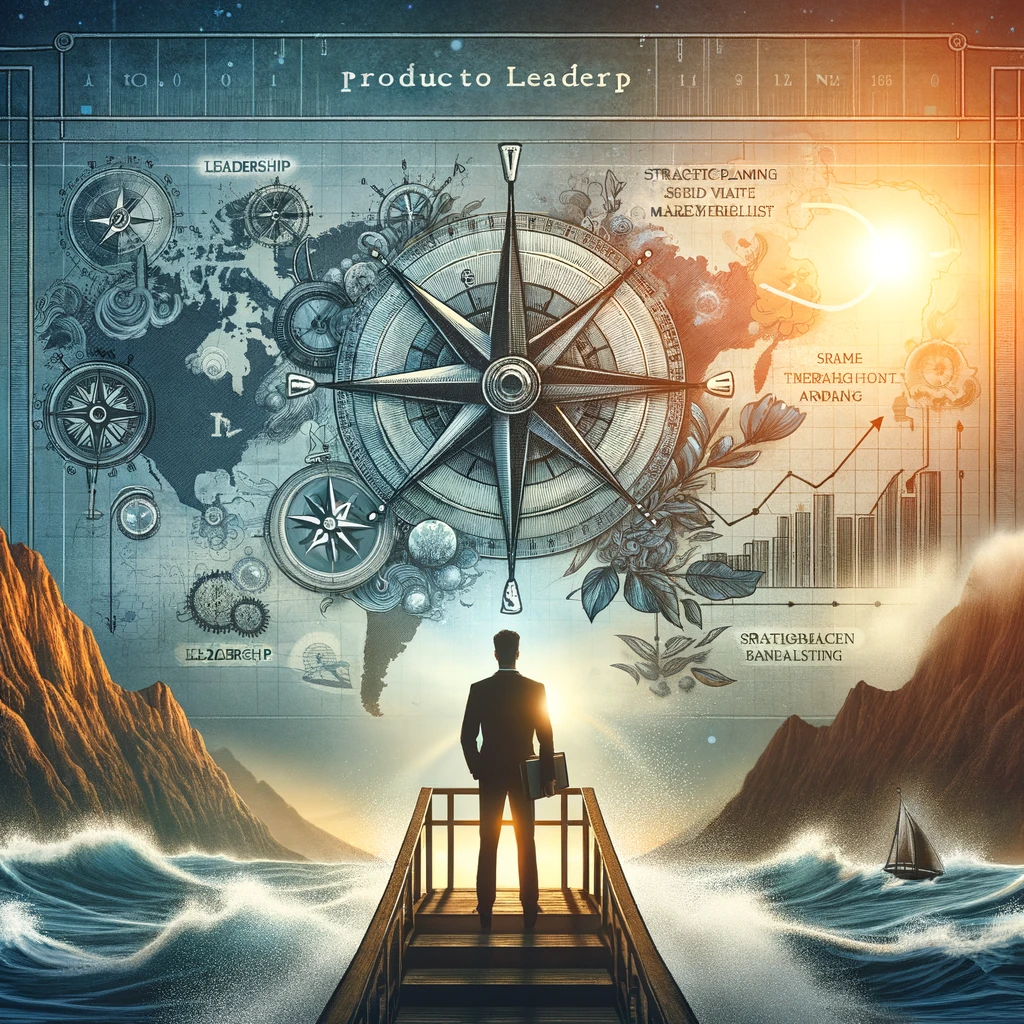In the dynamic world of product development, the concepts of product management and product leadership are pivotal. While often used interchangeably, they hold distinct roles in the lifecycle of a product.
Product management focuses on overseeing the development and lifecycle of a product, ensuring it meets market needs and company goals.
On the other hand, product leadership goes a step further, embodying the strategic vision and innovation that drive a product’s success in the market. This article delves into the essence of product leadership within the realm of product management, exploring its importance, evolution, and impact in today’s competitive business landscape.
In today’s fast-paced and competitive business environment, the fusion of these roles is critical for the success of any product. This article delves into the nuances of product leadership within the broader scope of product management, exploring its evolution, key responsibilities, and its growing importance in shaping market-leading products.
What is Product Leadership?
Product leadership is a strategic approach within product management, emphasizing innovation, vision, and market differentiation. Unlike traditional product management focused on development and execution, product leadership involves steering the product’s long-term direction and ensuring it resonates powerfully in the market. This role transcends operational tasks, requiring leaders to be visionaries who anticipate market trends and customer needs. Effective product leadership is about creating products that don’t just meet market standards but set new benchmarks, thereby establishing a product as a market leader in its category. It blends creative foresight with strategic acumen to drive product success and market dominance.
Who typically works with Product Leadership?
In most organizations, product leadership is typically undertaken by senior roles such as:
- Chief Product Officer (CPO): At the executive level, responsible for the overall product strategy and vision across the organization.
- VP of Product: Oversees the product management function, leading strategic initiatives and guiding product teams.
- Product Directors: Manage specific product lines or categories, ensuring alignment with the company’s strategic goals.
- Senior Product Managers: While often more hands-on with product management tasks, they also play a key role in shaping and driving the product strategy.
The Role of Product Leadership in Various Organizational Structures
The impact of product leadership significantly varies based on the company’s size, industry, and organizational structure. In larger organizations, product leadership roles might include Chief Product Officers or Vice Presidents of Product, overseeing expansive product lines and strategic directions.
Conversely, in smaller or newer companies, these responsibilities might fall to the CEO or CMO, where product leadership is more integrated with overall business strategy. Understanding these dynamics is crucial for product leaders to effectively navigate and influence the product’s success within their specific organizational context. This adaptability and understanding of different structures are key to effective product leadership.
Core Responsibilities of Product Leaders
Product leaders shoulder a range of responsibilities that are crucial for the success of a product:
- Vision and Strategy Development: They define the overarching vision and strategic direction for the product, ensuring alignment with market trends and business objectives.
- Innovation Leadership: Product leaders drive innovation, identifying opportunities for new features or products that can give the company a competitive edge.
- Market Analysis and Customer Insight: They deeply understand market dynamics and customer preferences, using these insights to inform product decisions and strategies.
- Cross-functional Collaboration: Effective product leaders work closely with various teams, including marketing, sales, and development, to ensure cohesive efforts in product development and promotion.
- Performance Measurement: They establish key performance indicators (KPIs) to measure the success of the product strategy and make data-driven decisions for continuous improvement.
These responsibilities highlight the multifaceted role of product leaders in guiding a product’s journey from conception to market leadership.
Effective Practices for Product Leaders
Successful product leadership transcends beyond strategic planning to implementing effective practices that ensure the success of the product and the team. This involves:
- Empowering and Mentoring Teams: A product leader’s strength lies in their ability to build a cohesive, skilled team. This includes hiring the right talent, providing mentorship, and fostering an environment where each team member can thrive and contribute effectively.
- Encouraging a Collaborative Culture: Product leaders should foster a culture where collaboration is paramount. This includes breaking down silos between departments and encouraging open communication and teamwork.
- Instilling Customer-Centricity: Keeping the customer at the heart of product decisions is crucial. This means continually gathering customer feedback and ensuring the product aligns with their needs and expectations.
- Promoting Experimentation and Learning: In the fast-paced world of product development, encouraging a mindset of continuous experimentation and learning is key. This involves staying abreast of market trends, encouraging innovation, and being open to new ideas and approaches.
By focusing on these practices, product leaders can effectively guide their teams and products towards market success.
Skills and Traits of Successful Product Leaders
Successful product leaders possess a unique blend of skills and traits:
- Strategic Thinking: The ability to envision the future of the product and market, and plan accordingly.
- Innovative Mindset: A penchant for innovation and creativity, constantly seeking new ways to improve and differentiate the product.
- Strong Communication: Excellent communication skills to articulate vision, motivate teams, and align stakeholders.
- Customer-centric Approach: A deep understanding of customer needs and the ability to translate these into product features.
- Decisiveness and Flexibility: The capacity to make informed decisions swiftly and adapt to changing market conditions.
These qualities enable product leaders to guide their teams effectively and drive the product to success.
Strategies for Effective Product Leadership
Effective product leadership involves several key strategies:
- Fostering a Culture of Innovation: Encourage creativity and experimentation within the team.
- Engaging in Continuous Learning: Stay abreast of market trends and emerging technologies.
- Building and Empowering Teams: Create a collaborative environment where team members feel valued and empowered.
- Customer-Centric Product Development: Regularly engage with customers to understand their needs and incorporate feedback.
- Data-Driven Decision Making: Utilize data and analytics to inform strategy and validate decisions.
These strategies ensure that product leaders can effectively guide their teams and products towards market leadership.
Challenges in Product Leadership
Product leadership, while rewarding, comes with its own set of challenges:
- Balancing Innovation with Feasibility: One of the biggest challenges is striking a balance between innovative ideas and their practical implementation. Product leaders must navigate limited resources and technical constraints while pushing for breakthroughs.
- Market Adaptability: Rapidly changing market trends and consumer behaviors can make it challenging to maintain a relevant and competitive product strategy.
- Stakeholder Alignment: Ensuring that all stakeholders, from executives to development teams, are aligned with the product vision can be a complex task, requiring excellent communication and negotiation skills.
- Managing Expectations: Product leaders often face the challenge of managing high expectations from both the market and within their organizations, while dealing with the realities of product development cycles and market pressures.
- Risk Management: Making bold decisions involves risks. Product leaders must adeptly manage these risks without stifling innovation.
These challenges require product leaders to be adaptable, visionary, and resilient, continually evolving their strategies to steer their products successfully in the market.
Product Leadership vs. Product Management
While product leadership and product management are closely intertwined, they have distinct focuses:
- Strategic vs. Tactical: Product leadership is strategic, focusing on the vision and long-term direction of the product. In contrast, product management is more tactical, handling the day-to-day execution and operational aspects.
- Visionary vs. Executor: Product leaders are visionaries, setting the course for the product’s future. Product managers, on the other hand, are executors, turning the vision into reality through detailed planning and management.
- Market Shaping vs. Market Responding: Product leaders aim to shape the market with innovative products, while product managers respond to market needs with practical solutions.
Understanding these differences is key to effectively integrating both roles for successful product development and management.
The Evolution of Product Leadership
The concept of product leadership has evolved significantly over the years. Initially, product management was predominantly tactical, focusing on the logistical aspects of bringing a product to market.
However, as markets became more competitive and customer demands more sophisticated, the need for a more strategic approach emerged. This evolution gave rise to product leadership, a role that extends beyond managing day-to-day product development to shaping the product’s future in the marketplace.
Today, product leaders are expected to be forward-thinking, innovating continually, and aligning the product not only with current market needs but also with future trends and opportunities. This strategic vision differentiates product leadership from traditional product management roles, marking a shift towards a more dynamic, visionary approach to managing products.
Future Trends in Product Leadership
The landscape of product leadership is continuously evolving:
- Increased Emphasis on AI and Machine Learning: Emerging technologies like AI and ML are becoming integral in shaping product strategies, offering predictive insights and operational efficiencies.
- Greater Focus on User Experience: In the future, product leadership will increasingly prioritize enhancing the user experience, making it a central component of product strategy.
- Adoption of Agile and Lean Methodologies: Flexibility and speed in response to market changes will be crucial, with agile and lean methodologies playing a significant role in product development.
Staying attuned to these trends will be essential for product leaders to keep their strategies relevant and effective in the ever-changing business environment.

How do I become a Product Leader?
To become a product leader, one must focus on several key areas:
- Gain Extensive Experience: Start with a role in product management to understand the fundamentals. Experience across different stages of product development is crucial.
- Develop a Strategic Mindset: Learn to think strategically about product development, market positioning, and business impact.
- Enhance Leadership Skills: Strong leadership skills are essential. This includes team management, communication, and decision-making abilities.
- Stay Informed and Adapt: Keep up-to-date with industry trends, emerging technologies, and consumer behaviors.
- Build a Strong Network: Networking with other professionals can provide insights and opportunities for growth.
- Education and Training: Consider formal education or certifications in product management and related fields.
By focusing on these areas, you can build the necessary skills and experience to advance into a product leadership role. Book a mentor session with the Mesh Firm team to upgrade your PM skills
Conclusion
In conclusion, product leadership plays a crucial role in the realm of product management, defining the strategic vision and direction of a product.
The journey of a product leader involves navigating through challenges like aligning vision with execution, adapting to market changes, and managing stakeholder expectations.
The evolving landscape of product leadership, with its increasing emphasis on technologies like AI and ML, user experience, and agile methodologies, highlights the need for adaptability and forward-thinking in this role. As we look to the future, the significance of product leadership in driving innovation and market success remains more relevant than ever.
FAQ About Product Leadership
What is product leadership?
Product leadership is a strategic role in product management focusing on innovation, vision, and market differentiation.
How does product leadership differ from product management?
Product leadership is strategic and visionary, focusing on long-term goals and market trends, while product management is more tactical, handling day-to-day operational tasks.
Who typically handles product leadership in an organization?
Senior roles like Chief Product Officer (CPO), VP of Product, Product Directors, and Senior Product Managers typically undertake product leadership.
What skills are essential for product leaders?
Strategic thinking, innovation, strong communication, customer-centric approach, and decisiveness are key skills.
How can I become a product leader?
Gain extensive experience in product management, develop strategic and leadership skills, stay informed on industry trends, and consider relevant education or certifications.

